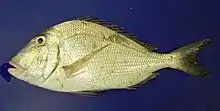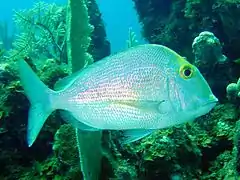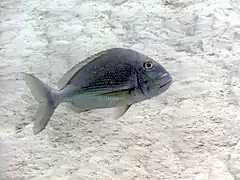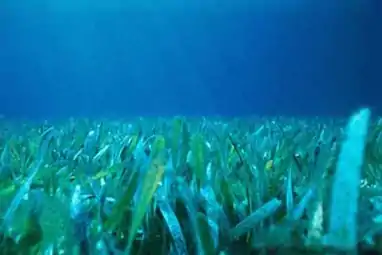Saucereye porgy
The saucereye porgy (Calamus calamus) is an ocean-going species of fish in the family Sparidae. In Bermuda, they are also known as the goat's head porgy.[1] In Jamaica, they are known as the Porgi grunt and the sugareye porgy. They may also be known simply by the name Porgy in several other Caribbean islands. Saucereye porgies are considered to be minor gamefishes and when caught are marketed both fresh and frozen.[2]
| Saucereye porgy | |
|---|---|
 | |
| Scientific classification | |
| Domain: | Eukaryota |
| Kingdom: | Animalia |
| Phylum: | Chordata |
| Class: | Actinopterygii |
| Order: | Spariformes |
| Family: | Sparidae |
| Genus: | Calamus |
| Species: | C. calamus |
| Binomial name | |
| Calamus calamus (Valenciennes, 1830) | |
| Synonyms | |
| |
Taxonomy and naming
The Saucereye porgy was first described by the French zoologist, Achille Valenciennes in a 22-volume work entitled Histoire naturelle des poissons (Natural History of Fishes), which was a collaboration with fellow zoologist, Georges Cuvier.[3] It was first described as Pagellus calamus, being placed in the genus Pagellus. It was since moved into Calamus, a genus named for the mythological Calamus, or Kalamos. It was so named because the Calamus of myth allowed himself to drown in a river, after the death of his lover, and transform into aquatic plants[4] that young saucereye porgies make their homes in.
Description
Saucereye porgies can grow up to 56 cm in length,[5] but normally they are 30 to 45 cm long.[6][7] Though some sources state that they can weigh up to 3 lbs,[8] the largest record is only half that: 1.5 lbs.[9] The cheek area is blue with yellow spots; there is also a dark blue smudge behind the upper gill opening.
 C. calamus in its natural habitat: A reef setting near Isla Juventud, Cuba.
C. calamus in its natural habitat: A reef setting near Isla Juventud, Cuba. C. calamus swimming over flats in Cozumel, Mexico.
C. calamus swimming over flats in Cozumel, Mexico.
Distribution and habitat
Saucereyes are found only in the western Atlantic ocean—from North Carolina, east to Bermuda, and south to Brazil.[10] They are most common around the cities of Key West and Havana. Adults are commonly found around coral reefs, where they are easily approached by divers,[11] while juveniles are common to beds of sea grass (mainly Thalassia). Saucereyes feed on a variety of animals, such as mollusks, sea worms, brittle stars, hermit crabs, crabs and sea urchins.[10]
Relationship with Humans
The Saurcereye porgy is mostly eaten by people in the West Indies, where it is most often caught. These fishes are also considered to be of minor commercial importance to the region, despite the occasional danger of ciguatera poisoning during red tide events.[12] They are usually marketed fresh or frozen. [2]
References
- Zaneveld, J.S. 1983 Caribbean Fish Life. Index to the local and scientific names of the marine fishes and fishlike invertebrates of the Caribbean area (Tropical Western Central Atlantic Ocean) E.J. Brill / Dr. W. Backhuys, Leiden, 163p.
- Cervigón, F., R. Cipriani, W. Fischer, L. Garibaldi, M. Hendrickx, A.J. Lemus, R. Márquez, J.M. Poutiers, G. Robaina and B. Rodriguez 1992 Fichas FAO de identificación de especies para los fines de la pesca. Guía de campo de las especies comerciales marinas y de aquas salobres de la costa septentrional de Sur América. FAO, Rome. 513 p. Preparado con el financiamento de la Comisión de Comunidades Europeas y de NORAD.
- Cuvier, G. and A. Valenciennes 1830 (Sept.) Historie naturelle des poissons. Tome Sixième. Livre sixième. Partie I. Des Sparoïdes; Partie II. Des Ménides. Histoire naturelle des poissons. v. 6: i-xxiv + 6 pp. + 1-559, Pls. 141-169. [Valenciennes is author of pp. 1-425, 493-559; Cuvier 426-491. i-xviii + 1-470 in Strasbourg ed.]
- Nonnos, Dionysiaca, translated by le Comte de Marcellus in 1856. Eglinton 1964: 474.
- Claro, R. 1994 Características generales de la ictiofauna. p. 55-70. In R. Claro (ed.) Ecología de los peces marinos de Cuba. Instituto de Oceanología Academia de Ciencias de Cuba and Centro de Investigaciones de Quintana Roo.
- Randall, J.E. and R. Vergara R. 1978 Sparidae. In W. Fischer (ed.) FAO species identification sheets for fishery purposes. Western Central Atlantic (Fishing Area 31). FAO, Rome. Vol. 5. pag.var. Paper URL
- Beebe, William. John Tee-Van. Field book of the shore fishes of Bermuda. New York. G.P. Putnam's Sons, 1933. Pp 159-160.
- Ackerman, Bill. Handbook of Fishes of the Atlantic Seaborad. The American Publishing Company. Washington D. C. pp. 58
- IGFA 2001 Database of IGFA angling records until 2001. IGFA, Fort Lauderdale, USA.
- Froese, Rainer; Pauly, Daniel (eds.) (2009). "Calamus calamus" in FishBase. 10 2009 version.
- Lieske, E. and R. Myers 1994 Collins Pocket Guide. Coral reef fishes. Indo-Pacific & Caribbean including the Red Sea. Harper Collins Publishers, 400 p.
- Dammann, A.E., 1969. Study of the fisheries potential of the Virgin Islands. Special Report. Contribution No. 1. Virgin Islands Ecological Research Station.
External links
- Saucereye porgy at Fishbase
- Photos of Saucereye porgy on Sealife Collection
